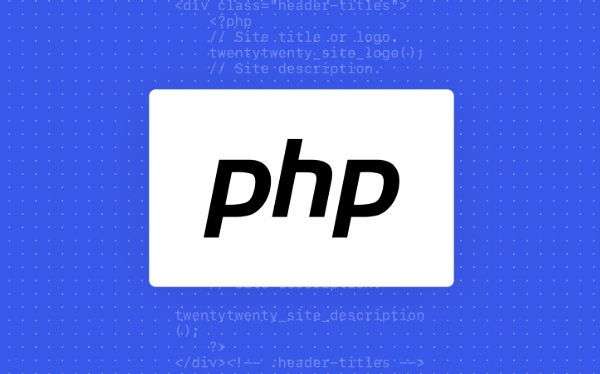 Backend Development
Backend Development
 PHP Tutorial
PHP Tutorial
 Advanced Conditional Patterns for Building Flexible PHP Applications
Advanced Conditional Patterns for Building Flexible PHP Applications
Advanced Conditional Patterns for Building Flexible PHP Applications
Jul 31, 2025 am 05:24 AMUse policy mode to replace conditional logic with interchangeable behavior; 2. Use empty object mode to eliminate null value checks; 3. Use state mode to make objects change behavior according to internal state; 4. Combining complex business rules through specification mode; 5. Combining command mode with guards to achieve unconditional execution control; 6. Use class-based distribution to replace switch statements; these modes improve the maintainability, testability and scalability of the code by converting conditional logic into polymorphism and combinations, thereby building more flexible PHP applications.

When building flexible and maintainable PHP applications, relying solely on basic if-else statements can quickly lead to rigid, hard-to-maintain code. Advanced conditional patterns allow developers to write more dynamic, scalable, and readable logic. These patterns go beyond simple branching and embrace design principles that promote separation of concerns, testability, and extension.

Here are several advanced conditional patterns you can use to make your PHP applications more adaptable.
1. Strategy Pattern: Replace Conditional Logic with Interchangeable Behaviors
Instead of using long switch or if-elseif chains to determine behavior, encapsulate each variation into its own class using the Strategy pattern.

Example: Payment Processing
interface PaymentProcessor
{
public function process(float $amount): bool;
}
class CreditCardProcessor implements PaymentProcessor
{
public function process(float $amount): bool
{
// Process credit card
return true;
}
}
class PayPalProcessor implements PaymentProcessor
{
public function process(float $amount): bool
{
// Process via PayPal
return true;
}
}
class PaymentService
{
private PaymentProcessor $processor;
public function setProcessor(PaymentProcessor $processor): void
{
$this->processor = $processor;
}
public function execute(float $amount): bool
{
return $this->processor->process($amount);
}
}Why it's better:

- No conditions needed when selecting logic
- Easy to add new payment methods
- Promotes dependency injection and testing
Use this when:
- You have multiple algorithms for the same task
- Behavior changes based on context or configuration
2. Null Object Pattern: Eliminate Null Checks
Instead of scattering if ($object !== null) checks, use a Null Object that implements the same interface but does nothing.
interface Logger
{
public function log(string $message);
}
class FileLogger implements Logger
{
public function log(string $message)
{
file_put_contents('app.log', $message . PHP_EOL, FILE_APPEND);
}
}
class NullLogger implements Logger
{
public function log(string $message)
{
// Do nothing
}
}
class UserService
{
private Logger $logger;
public function __construct(Logger $logger = null)
{
$this->logger = $logger ?? new NullLogger(); // Avoid null checks
}
public function register(string $email)
{
// No need to check if logger is null
$this->logger->log("User registered: $email");
}
}Benefit: Cleaner code, fewer defending conditions.
3. State Pattern: Let Objects Change Behavior Based on Internal State
When an object's behavior changes drastically based on its state, avoid conditions like if ($status === 'active') by externalizing state logic.
interface OrderState
{
public function ship(OrderContext $order);
public function cancel(OrderContext $order);
}
class PendingState implements OrderState
{
public function ship(OrderContext $order) { /* Not allowed */ }
public function cancel(OrderContext $order) { $order->setState(new CancelledState()); }
}
class ShippedState implements OrderState
{
public function ship(OrderContext $order) { /* Already shipped */ }
public function cancel(OrderContext $order) { /* Can't cancel */ }
}
class OrderContext
{
private OrderState $state;
public function __construct()
{
$this->state = new PendingState();
}
public function setState(OrderState $state)
{
$this->state = $state;
}
public function ship() { $this->state->ship($this); }
public function cancel() { $this->state->cancel($this); }
}This removes conditions like:
if ($this->status === 'pending') {
$this->status = 'shipped';
}Instead, behavior is delegated to the current state object.
4. Specification Pattern: Compose Complex Business Rules
Use boolean logic via objects to represent business rules. This is especially useful for validation or filtering.
interface Specification
{
public function isSatisfiedBy($candidate): bool;
public function and(Specification $other): Specification;
public function or(Specification $other): Specification;
public function not(): Specification;
}
class AgeSpecification implements Specification
{
private int $minAge;
public function __construct(int $minAge)
{
$this->minAge = $minAge;
}
public function isSatisfiedBy($candidate): bool
{
return $candidate->age >= $this->minAge;
}
public function and(Specification $other): Specification
{
return new AndSpecification($this, $other);
}
// ... similarly for or(), not()
}Now you can compose rules:
$canVote = (new AgeSpecification(18))->and(new CitizenshipSpecification('US'));
if ($canVote->isSatisfiedBy($user)) { ... }This replaces complex nested conditions with readable, reusable rule objects.
5. Command Pattern with Guards: Conditional Execution Without Ifs
Combine the Command pattern with preconditions (guards) to control execution flow.
interface Command
{
public function canExecute(): bool;
public function execute();
}
class DeleteAccountCommand implements Command
{
private User $user;
public function __construct(User $user)
{
$this->user = $user;
}
public function canExecute(): bool
{
return $this->user->isVerified() && !$this->user->hasActiveSubscriptions();
}
public function execute()
{
if (!$this->canExecute()) {
throw new RuntimeException("Cannot execute command");
}
// Perform deletion
}
}Then process commands generally:
foreach ($commands as $cmd) {
if ($cmd->canExecute()) {
$cmd->execute();
}
}This centralizes conditional logic and makes command pipelines easy to manage.
6. Use Class-Based Dispatching instead of Switch Statements
Instead of:
switch ($type) {
case 'pdf': return new PdfExporter();
case 'csv': return new CsvExporter();
// ...
}Use a map of types to classes:
class ExporterFactory
{
private array $map = [
'pdf' => PdfExporter::class,
'csv' => CsvExporter::class,
];
public function make(string $type): Exporter
{
if (!isset($this->map[$type])) {
throw new InvalidArgumentException("Unknown type: $type");
}
return new $this->map[$type]();
}
}Even better: use a DI container to resolve them dynamically.
Final Thoughts
Advanced conditional patterns help you:
- Reduce code duplication
- Improve testability
- Make systems easier to extend
- Avoid deep nesting and cyclomatic complexity
Instead of asking "what should I do next?" in conditions, ask:
- Can this be an object?
- Can this be injected?
- Can this be composed?
By replacing conditions with polymorphism and composition, you build systems that are easier to reason about and evolve over time.
Basically, if you're writing if statements to decide what kind of thing to do — it's probably time to use a pattern.
The above is the detailed content of Advanced Conditional Patterns for Building Flexible PHP Applications. For more information, please follow other related articles on the PHP Chinese website!

Hot AI Tools

Undress AI Tool
Undress images for free

Undresser.AI Undress
AI-powered app for creating realistic nude photos

AI Clothes Remover
Online AI tool for removing clothes from photos.

Clothoff.io
AI clothes remover

Video Face Swap
Swap faces in any video effortlessly with our completely free AI face swap tool!

Hot Article

Hot Tools

Notepad++7.3.1
Easy-to-use and free code editor

SublimeText3 Chinese version
Chinese version, very easy to use

Zend Studio 13.0.1
Powerful PHP integrated development environment

Dreamweaver CS6
Visual web development tools

SublimeText3 Mac version
God-level code editing software (SublimeText3)
 The `elseif` vs. `else if` Debate: A Deep Dive into Syntax and PSR Standards
Jul 31, 2025 pm 12:47 PM
The `elseif` vs. `else if` Debate: A Deep Dive into Syntax and PSR Standards
Jul 31, 2025 pm 12:47 PM
elseif and elseif function are basically the same in PHP, but elseif should be preferred in actual use. ① Elseif is a single language structure, while elseif is parsed into two independent statements. Using elseif in alternative syntax (such as: and endif) will lead to parsing errors; ② Although the PSR-12 encoding standard does not explicitly prohibit elseif, the use of elseif in its examples is unified, establishing the writing method as a standard; ③ Elseif is better in performance, readability and consistency, and is automatically formatted by mainstream tools; ④ Therefore, elseif should be used to avoid potential problems and maintain unified code style. The final conclusion is: elseif should always be used.
 Mastering Conditional Control Flow with PHP's if-else Constructs
Jul 31, 2025 pm 12:46 PM
Mastering Conditional Control Flow with PHP's if-else Constructs
Jul 31, 2025 pm 12:46 PM
PHP's if-else statement is the core tool for implementing program dynamic control. 1. The basic if-else structure supports binary decision-making and executes different code blocks according to the true or false conditions; 2. Use elseif to judge in sequence in multiple conditions, and stop subsequent inspections once a certain condition is true; 3. Accurate conditions should be constructed by combining comparison operators (such as === to ensure that the types and values are equal) and logical operators (&&, ||,!); 4. Avoid misuse of assignment operations in conditions, and == or === for comparison; 5. Although nested if statements are powerful, they are easy to reduce readability, it is recommended to use early return to reduce nesting; 6. The ternary operator (?:) is suitable for simple conditional assignment, and you need to pay attention to readability when using chains; 7. Multiple
 Advanced Conditional Patterns for Building Flexible PHP Applications
Jul 31, 2025 am 05:24 AM
Advanced Conditional Patterns for Building Flexible PHP Applications
Jul 31, 2025 am 05:24 AM
Use the policy mode to replace the conditional logic with interchangeable behavior; 2. Use the empty object mode to eliminate null value checks; 3. Use the state mode to let the object change behavior according to the internal state; 4. Combining complex business rules through the specification mode; 5. Combining command mode and guards to achieve unconditional execution control; 6. Use class-based distribution to replace switch statements; these modes improve the maintainability, testability and scalability of the code by converting the conditional logic into polymorphism and combination, thereby building a more flexible PHP application.
 The Pitfalls of Type Juggling: `==` vs. `===` in Conditional Checks
Jul 31, 2025 pm 12:41 PM
The Pitfalls of Type Juggling: `==` vs. `===` in Conditional Checks
Jul 31, 2025 pm 12:41 PM
Using === instead of == is the key to avoiding the risk of type conversion in PHP, because == will make loose comparisons, resulting in errors such as '0'==0 or strpos returning 0, causing security vulnerabilities and logical bugs. === prevents such problems by strictly comparing values and types. Therefore, === should be used by default, and explicitly converting types when necessary, and at the same time, combining declare(strict_types=1) to improve type safety.
 Using `if...else` for Robust Input Validation and Error Handling
Aug 01, 2025 am 07:47 AM
Using `if...else` for Robust Input Validation and Error Handling
Aug 01, 2025 am 07:47 AM
Checkforemptyinputusingifnotuser_nametodisplayanerrorandpreventdownstreamissues.2.Validatedatatypeswithifage_input.isdigit()beforeconvertingandchecklogicalrangestoavoidcrashes.3.Useif...elif...elseformultipleconditions,providingspecificfeedbacklikemi
 Integrating `if...else` Logic within Loops for Dynamic Control Flow
Jul 30, 2025 am 02:57 AM
Integrating `if...else` Logic within Loops for Dynamic Control Flow
Jul 30, 2025 am 02:57 AM
Usingif...elseinsideloopsenablesdynamiccontrolflowbyallowingreal-timedecisionsduringeachiterationbasedonchangingconditions.2.Itsupportsconditionalprocessing,suchasdistinguishingevenandoddnumbersinalist,byexecutingdifferentcodepathsfordifferentvalues.
 Beyond `elseif`: Leveraging the `match` Expression in Modern PHP
Jul 31, 2025 pm 12:44 PM
Beyond `elseif`: Leveraging the `match` Expression in Modern PHP
Jul 31, 2025 pm 12:44 PM
Match expressions are better than elseif chains because of their concise syntax, strict comparison, expression return values, and can ensure integrity through default; 2. Applicable to map strings or enumerations to operations, such as selecting processors based on state; 3. Combining enumerations with PHP8.1 can achieve type-safe permission allocation; 4. Support single-branch multi-value matching, such as different MIME types classified into the same category; 5. Return closures to delay execution logic; 6. Limitations include only supporting equal value comparisons, no fall-through mechanism, and not applying complex conditions; 7. Best practices include always adding default branches, combining early returns, for configuration or routing mapping, and throwing exceptions when invalid inputs are ineffective to quickly lose
 Writing Readable and Maintainable Conditional Logic
Jul 31, 2025 am 10:21 AM
Writing Readable and Maintainable Conditional Logic
Jul 31, 2025 am 10:21 AM
Use meaningful variable names to encapsulate complex conditions to improve readability and maintainability; 2. Reduce nesting levels by returning in advance to make the main logic clearer; 3. Replace long lists of if-else or switches with lookup tables or maps to enhance simplicity and scalability; 4. Avoid negative conditions and give priority to forward logical expression; 5. Abstract public condition logic into independent functions to improve reusability and semanticity. Together, these practices ensure that the condition code is clear, easy to understand and subsequent maintenance.





